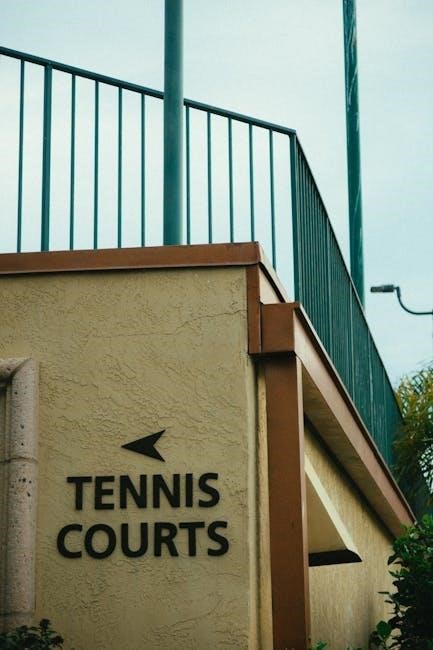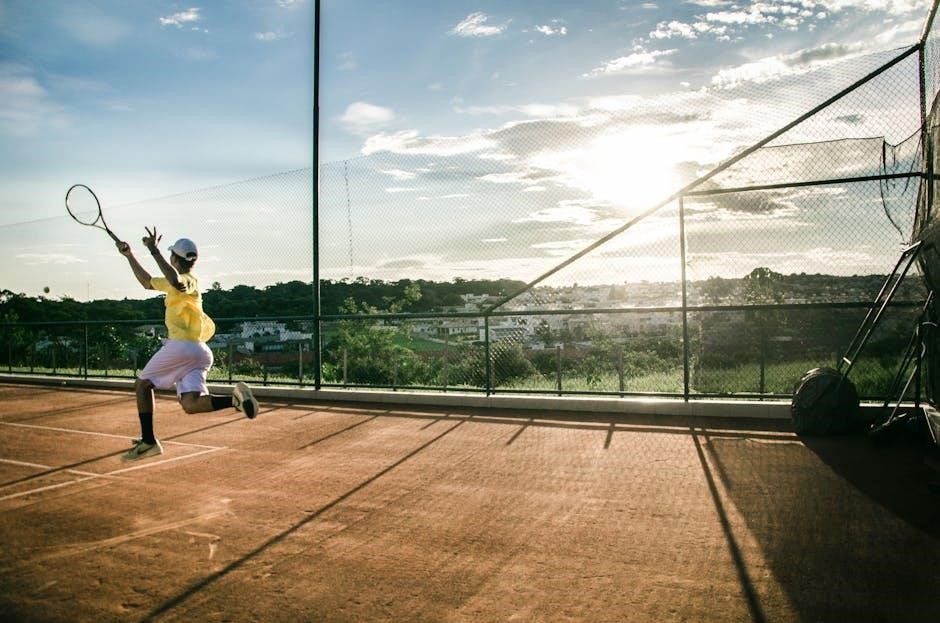Tennis court dimensions are crucial for ensuring fair play and consistency across all levels of the sport. Official standards, detailed in PDF guides, provide precise measurements and layouts for courts, including run-off zones, net heights, and line widths. These resources are essential for constructing and maintaining courts, ensuring safety, and meeting regulatory requirements for optimal play conditions.
Overview of Tennis Court Layout
A tennis court’s layout is meticulously designed to ensure uniformity and fairness in play. The Principal Playing Area (PPA) measures 23.77m in length and 10.97m in width for doubles, narrowing to 8.23m for singles. The court features a center mark, service lines, sidelines, and baselines, with lines ranging from 2.5cm to 10cm in width. Run-off zones around the court enhance player safety, while the net, positioned at 1.07m high, divides the court into two equal halves. These precise dimensions, outlined in official PDF guides, ensure consistency across all levels of play, from recreational to professional competitions.
Importance of Accurate Dimensions in Tennis
Accurate tennis court dimensions are vital for fair play, safety, and competitive integrity. Precise measurements ensure consistent gameplay, preventing disputes and injuries. The ITF standards, detailed in PDF guides, mandate exact line widths, net heights, and run-off zones. Inaccurate dimensions can lead to safety hazards, unfair advantages, and disqualification in official matches. Properly marked courts also enhance player performance by providing clear boundaries and visual cues. Adherence to these standards guarantees a level playing field, making accurate dimensions fundamental to the sport’s integrity and enjoyment at all levels, from recreational to professional play.
Key Measurements for Singles and Doubles Courts
Singles courts measure 23.77m in length and 8.23m in width, while doubles courts are 23.77m long and 10.97m wide. The net height is 1;07m at the center, tapering to 1.02m at the posts. Service lines are 6.40m from the net for singles and 6.40m for doubles, with baselines and sidelines clearly marked. These measurements ensure consistent gameplay and fair competition, as outlined in official PDF guides. Compliance with these standards is essential for maintaining the integrity of both professional and recreational matches, ensuring a uniform experience for all players and spectators alike.

Standard Tennis Court Dimensions
Standard tennis court dimensions are 23.77m long and 8.23m wide for singles, expanding to 10.97m wide for doubles. The net stands at 1.07m high, ensuring fair play and uniformity across all levels of the sport.
Length and Width for Singles Courts
A singles tennis court measures 23.77 meters in length and 8.23 meters in width. These dimensions ensure a balanced playing area for two players, allowing for optimal movement and gameplay. The net, placed at the center, stands 1.07 meters high, dividing the court into two equal halves. The service line, located 6.40 meters from the net, further divides the court, creating clear zones for serves and rallies. These precise measurements are essential for maintaining fairness and consistency in singles matches at all competitive levels.
Length and Width for Doubles Courts
A doubles tennis court measures 23.77 meters in length and 10.97 meters in width, providing a larger playing area to accommodate four players. The increased width allows for more space along the sidelines, enabling doubles teams to position themselves effectively. The net remains at the same height of 1.07 meters, and the service lines are positioned 6.40 meters from the net. The sidelines are wider than in singles courts, offering more room for lateral movement and strategic plays. These dimensions ensure fair and competitive gameplay for doubles matches at all levels of tennis.
Net Dimensions and Height
The net in a tennis court is a critical element, standing at a height of 1.07 meters in the center and 1.07 meters at the posts, ensuring consistency across the court. The net spans the entire width of the court, measuring 12.8 meters for doubles matches and 10.97 meters for singles. The center of the net features a white mark, 10 centimeters in length, aligning with the center line of the court. The net must be tightly secured to the posts and should not sag below the specified height to maintain fair play. Proper net dimensions and tension are essential for safe and competitive gameplay.
Additional Spaces and Clearances
Tennis courts require additional run-off zones for player safety, ensuring clearance behind baselines and sidelines. These spaces prevent collisions with fences or structures, enhancing safety during play.
Run-Off Zones for Player Safety
Run-off zones are essential for player safety, providing additional space beyond the court boundaries. These areas minimize the risk of injury from collisions with fences or obstacles. The International Tennis Federation recommends at least 6.40 meters behind baselines and 3.66 meters beside sidelines for professional play. Properly designed run-off zones ensure players can move freely without hazards, contributing to a safer and more enjoyable playing environment. Clearances must be maintained to meet official standards, ensuring optimal safety for all competitors.
Minimum Distance Between Baselines and Backstops
The minimum distance between baselines and backstops is critical for player safety and optimal play. International standards recommend at least 21 feet (6.40 meters) for baselines and 12 feet (3.66 meters) for sidelines. Proper clearance allows players to move safely and prevents collisions with fencing or obstructions. Adhering to these guidelines ensures compliance with official regulations and enhances the overall playing environment. This spacing also accommodates player movement during intense matches, maintaining fair play and safety.
Minimum Distance Between Sidelines and Sidestops
The minimum distance between sidelines and sidestops is essential for player safety and optimal court functionality. International guidelines recommend maintaining at least 12 feet (3.66 meters) between the sidelines and any adjacent structures or fencing. This clearance ensures players have ample space to move without risking collisions or injuries. Proper spacing also allows for unobstructed access to the court and adheres to official tennis regulations. Maintaining these standards ensures a safe and fair environment for competitive and recreational play, aligning with global court construction guidelines.

Court Line Measurements
Tennis court lines must adhere to specific widths for consistency and fairness. The center mark and service lines are 2 inches (5 cm) wide, while other lines range from 1 to 2 inches (2.5 to 5 cm), except the baseline, which can be up to 4 inches (10 cm) wide. These measurements ensure clear visibility and compliance with official standards, as detailed in court dimension PDF guides.
Width of Baseline and Service Lines
The baseline and service lines are critical components of a tennis court, with specific width requirements. The baseline can be up to 10 cm wide, providing clear visibility for players and officials. Service lines are 2 inches (5 cm) wide, ensuring precise placement for serves. These measurements are standardized to maintain consistency across all courts, as outlined in official PDF guides. Proper line widths are essential for fair play and adherence to regulations, making them a focal point in court design and maintenance. Accurate measurements ensure optimal playing conditions for all levels of competition.
Width of Sidelines and Center Lines
The sidelines and center lines on a tennis court have specific width requirements to ensure consistency and visibility. The center line is typically 50mm wide, while the sidelines are between 25mm and 50mm wide. These measurements are standardized to maintain uniformity across all courts, as detailed in official PDF guides. The precise widths ensure clear visibility for players and officials, contributing to fair play and accurate calls. Properly marked sidelines and center lines are essential for maintaining the integrity of the game, as outlined in the official regulations for court dimensions and markings.
Center Mark and Service Line Dimensions
The center mark and service line dimensions are critical for accurate court setup. The center mark is 10 cm long and 5 cm wide, positioned at the baseline’s midpoint. Service lines are 5 cm wide and 21 cm long, placed 4.57 meters from the net on both sides. These measurements ensure precise service areas and accurate calls. The center mark aligns parallel with the sidelines, while service lines are perpendicular to the net. Official PDF guides specify these dimensions for consistency across all courts, ensuring fair play and adherence to International Tennis Federation (ITF) standards. Proper marking is essential for maintaining game integrity and player accuracy.

Tennis Court Surfaces and Their Impact on Dimensions
Tennis court surfaces, such as acrylic, asphalt, grass, or clay, affect play characteristics but not standard dimensions. Surface type influences bounce, speed, and maintenance requirements for optimal performance and durability. Official PDF guides detail surface-specific considerations to ensure consistent play conditions across different materials and court types, maintaining fair play and player safety.
Hard Courts and Their Specific Dimensions
Hard courts, made from materials like acrylic or asphalt, provide a fast-playing surface with consistent bounce. Their dimensions adhere strictly to ITF standards, ensuring a principal playing area of 23.77m x 10.97m for doubles and 23.77m x 8.23m for singles. The net height remains 1.07m at the center. Run-off zones and clearances are maintained as specified, typically 6.40m behind baselines and 3.66m alongside sidelines. These courts are durable and low-maintenance, making them popular for both professional and recreational play. Official PDF guides detail these measurements to ensure compliance and optimal performance for all players.
Clay Courts and Their Measurements
Clay courts, known for their slow-playing surface, require specific measurements to maintain performance and safety. The principal playing area for doubles is 23.77m x 10;97m, while singles courts measure 23.77m x 8.23m. The net height is 1.07m at the center. Additional run-off zones and clearances are essential, typically 6.40m behind baselines and 3;66m alongside sidelines. Unlike hard courts, clay surfaces need regular maintenance to preserve their texture and drainage. Official PDF guides outline these dimensions, ensuring that clay courts meet ITF standards for both competitive and recreational play, while accommodating the unique characteristics of clay surfaces.
Grass Courts and Their Unique Requirements
Grass courts, traditionally used in prestigious tournaments like Wimbledon, have specific dimensional and maintenance needs. The principal playing area for doubles is 23.77m x 10.97m, and singles courts are 23.77m x 8.23m. The net height remains 1.07m at the center. Grass courts require regular mowing and watering to maintain a uniform surface and drainage. Unlike hard or clay courts, grass surfaces demand additional care to prevent uneven wear and ensure consistent bounce. PDF guides detail these requirements, emphasizing the need for precise measurements and maintenance to uphold the unique characteristics and playability of grass courts.
Artificial Surfaces and Their Dimensions
Artificial tennis surfaces, such as acrylic or synthetic courts, offer durability and consistent play. The standard dimensions for doubles courts remain 23.77m x 10.97m, while singles courts measure 23.77m x 8.23m. The net height stays consistent at 1.07m. These surfaces require specific installation and maintenance to ensure optimal performance. PDF guides provide detailed specifications for artificial courts, including material requirements and construction guidelines. They are popular for recreational and training purposes due to their low maintenance and ability to replicate the feel of natural surfaces like grass or clay.
Variations in Court Dimensions

Tennis court dimensions vary slightly for different surfaces and formats, such as beach tennis, pickleball, or junior courts. Official PDF guides provide standardized measurements for these adaptations, ensuring consistency and fairness across all formats and surfaces.
Beach Tennis Court Dimensions
Beach tennis courts have distinct dimensions tailored to the sport’s unique requirements. The court measures 16 meters in length, with a width of 8 meters for doubles matches and 4.5 meters for singles matches; The net height is set at 1.7 meters, slightly lower than standard tennis nets, to accommodate the faster-paced, sand-based gameplay. These dimensions ensure optimal playability while maintaining the sport’s dynamic nature. Official PDF guides provide detailed measurements and layouts for beach tennis courts, helping to standardize the setup for consistent play across all levels of competition and recreational use.
Pickleball Court Dimensions vs. Tennis Courts
Pickleball courts differ significantly from tennis courts in size and layout. A pickleball court measures 20×44 feet, compared to a tennis court’s 78×27 feet for singles and 78×36 feet for doubles. The smaller dimensions of pickleball courts make them more accessible and suitable for a wider range of players. Additionally, pickleball courts feature shorter nets and distinct non-volley zones, which are not present in tennis. These differences highlight the unique design requirements for each sport, as outlined in official PDF guides, ensuring optimal playability and adherence to specific rules for both disciplines.
Junior Tennis Court Dimensions
Junior tennis court dimensions are scaled down to accommodate younger players, promoting skill development and accessibility. For 8 and Under players, courts measure 36×18 feet with a 2.5-foot-high net. The 10 and Under category uses 60×21 feet courts with a 3-foot-high net. These smaller dimensions allow children to learn the game more effectively, with shorter rallies and easier ball control. The ITF and official guidelines provide detailed PDF resources for constructing junior courts, ensuring proper scaling and safety. This adaptability helps young players transition smoothly to full-sized courts as they grow and improve.

Official Standards and Guidelines
Official tennis court dimensions are governed by the International Tennis Federation (ITF), ensuring consistency and safety. Detailed PDF guides outline measurements, line widths, and safety clearances for all courts.
International Tennis Federation (ITF) Standards
The International Tennis Federation (ITF) sets the global standard for tennis court dimensions, ensuring uniformity across all levels of play. According to ITF guidelines, a singles court measures 23.77 meters in length and 8.23 meters in width, while a doubles court is 23.77 meters long and 10.97 meters wide. The net height is specified at 1.07 meters at the center and 1.04 meters at the posts. The ITF also outlines requirements for line widths, with baselines up to 10 cm wide and other lines between 2.5 cm and 5 cm. These standards are detailed in official PDF guides, which include diagrams and measurements for optimal court construction and safety. Compliance with ITF standards ensures fair play and consistency in competitive and recreational tennis.
NCAA and Collegiate Tennis Court Dimensions
NCAA and collegiate tennis courts adhere to standards slightly varying from ITF regulations to accommodate specific competition needs. Singles courts measure 78 feet (23.77 meters) in length and 27 feet (8.23 meters) in width, aligning with professional standards. Doubles courts are 78 feet long and 36 feet (10.97 meters) wide. The net height remains consistent at 3 feet (0.91 meters) at the center and 3.5 feet (1.07 meters) at the posts. These dimensions ensure consistency and fairness in collegiate matches, detailed in NCAA-published PDF guides for court construction and maintenance, ensuring safety and compliance with competitive standards.
Local and Recreational Court Variations
Local and recreational tennis courts often adapt standard dimensions to fit community needs and available space. While maintaining the core dimensions of 78 feet (23.77 meters) in length, widths may vary slightly for singles or doubles play. Line widths and net heights typically follow official guidelines, but flexibility exists for informal play. Run-off zones may be reduced in smaller facilities, prioritizing safety without compromising playability. These variations ensure accessibility and practicality for community courts, balancing official standards with local requirements, as detailed in PDF guides for recreational court construction and maintenance.

Court Maintenance and Marking
Regular maintenance ensures optimal playability. Acrylic coatings are recommended for hard courts, while clay courts need consistent grooming. Lines must be repainted annually, and surfaces inspected regularly.
Guidelines for Painting Court Lines
Painting court lines requires precision to ensure accurate dimensions. All lines must be measured carefully, with baseline widths ranging from 2.54 cm to 10.16 cm. Sidelines and center lines should be 5.08 cm wide, while service lines are 5 cm wide. Use durable acrylic paint for visibility and longevity. Ensure lines are painted within the specified measurements, maintaining consistency across the court. Allow paint to dry completely before play. Follow ITF standards for color consistency, typically white lines on colored surfaces. Proper painting ensures clear visibility and adherence to official regulations, essential for fair play and competitive standards.
Material Recommendations for Line Marking
For line marking, use high-quality, durable materials to ensure visibility and longevity. Acrylic paint is the most common choice due to its UV resistance and vibrant colors. Water-based paints are eco-friendly and cost-effective, while thermoplastic materials offer long-lasting, heat-applied lines. Pre-formed vinyl tapes are also popular for their ease of application and removable nature. All materials should adhere to ITF standards, ensuring lines are clearly visible and maintain consistent dimensions. Proper material selection ensures the court remains playable and visually appealing, meeting the demands of both recreational and competitive play.
Regular Maintenance Tips for Optimal Play
Regular maintenance ensures tennis courts remain safe and playable. Inspect surfaces for cracks or wear, addressing them promptly to prevent further damage. Clean lines and markings to maintain visibility, especially after harsh weather conditions. Resurface courts every 5-7 years to restore grip and evenness. Check net height and tension regularly, adjusting as needed. Ensure proper drainage to prevent water accumulation, which can lead to slippery surfaces. Schedule professional inspections annually to identify potential issues early. Consistent upkeep preserves court longevity and enhances player performance, ensuring optimal play conditions throughout the year.

Safety Considerations
Safety is paramount in tennis court design. Proper clearances around courts, secure fencing, and well-marked player safety zones minimize risks and injuries during play.
Clearances Around the Court
Proper clearances around the tennis court are essential for player safety and optimal performance; The International Tennis Federation (ITF) recommends a minimum distance of 21 feet (6.40 meters) between baselines and backstops, and 12 feet (3.66 meters) between sidelines and sidestops. These clearances ensure players have ample space to move freely without obstruction. Additionally, run-off zones around the court reduce the risk of injuries from collisions with fences or other structures. Clearances may vary depending on the level of competition, with higher standards requiring greater safety margins. Proper fencing and lighting are also critical to prevent accidents and ensure visibility during play.

Fencing and Lighting Requirements
Fencing and lighting are vital components of tennis court safety and functionality. Fencing should be at least 3.6 meters high to prevent balls from exiting the court and to ensure player containment. Lighting must provide uniform illumination, typically requiring a minimum of 500 lux for professional play and 300 lux for recreational use. Poles should be positioned outside the court to avoid obstructing play, with spacing and height adjusted to minimize glare and shadows. Proper fencing and lighting ensure safe and enjoyable gameplay, especially during evening matches. These standards are outlined in official PDF guides for court construction and maintenance.
Player Safety Zones
Player safety zones are essential for preventing injuries and ensuring fair play. These zones include run-off areas and clearances around the court. The International Tennis Federation (ITF) recommends a minimum of 6.40 meters behind baselines and 3.66 meters beside sidelines to provide adequate space for players to move safely. Properly marked safety zones help avoid collisions with fences or other obstacles. These clearances are critical for high-level competitions and recreational play alike, ensuring players can compete without unnecessary risks. Adhering to these standards is vital for maintaining player well-being and upholding the integrity of the game.

Downloading Tennis Court Dimension PDFs
Official tennis court dimension PDFs are available from the ITF and NCAA websites, providing detailed guidelines for constructing and maintaining courts according to international standards and regulations.
Where to Find Official PDF Guides
Official tennis court dimension PDFs can be found on the International Tennis Federation (ITF) website, NCAA resources, and sports equipment supplier sites. These guides provide detailed court layouts, measurement standards, and construction tips; They are essential for ensuring compliance with official regulations. Additionally, websites like SportsEquip.co.uk offer downloadable PDFs for specific court designs and surfacing requirements. These resources are invaluable for contractors, facility managers, and tennis enthusiasts aiming to build or maintain courts according to professional standards. Always verify the source to ensure accuracy and adherence to the latest guidelines.
What to Expect in a Dimension PDF
A tennis court dimension PDF typically includes detailed diagrams, measurements, and specifications for both singles and doubles courts. Key elements such as court length, width, and net height are clearly outlined. You’ll find information on run-off zones, baseline clearances, and service line dimensions. Additionally, these guides often cover line widths, center mark details, and safety zones. Some PDFs also provide guidelines for painting and maintaining court surfaces. They serve as comprehensive resources for constructing, renovating, or verifying the accuracy of tennis courts, ensuring compliance with international and local standards for optimal playability and safety.
How to Use PDF Guides for Court Construction
When constructing a tennis court, PDF guides provide essential blueprints and measurements. Start by reviewing the diagrams to understand the layout and dimensions for singles or doubles courts. Use the specified measurements for court length, width, and net height to ensure accuracy. Check the recommended run-off zones and clearances to guarantee player safety. Refer to the line width specifications and marking guidelines for precise painting. Ensure all constructions adhere to ITF standards for professional play. These guides are invaluable for contractors, architects, and facility managers to build courts that meet regulatory and safety requirements effectively.
Tennis court dimensions are crucial for fair play and safety. PDF guides provide precise measurements, ensuring adherence to ITF standards and optimal court construction.
Tennis court dimensions are standardized to ensure fair play and consistency. The Principal Playing Area (PPA) for singles is 23.77m x 8.23m, and for doubles, it is 23.77m x 10.97m. Additional run-off zones are required for safety. The net height is 1.07m at the center, and baseline markings are 10cm wide. Official PDF guides provide detailed measurements, including line widths and safety clearances, to aid in court construction and maintenance. These standards, set by the ITF, ensure optimal play conditions for all levels of competition.
Final Thoughts on Tennis Court Dimensions
Accurate tennis court dimensions are essential for fair play and consistency. Official PDF guides provide detailed measurements, ensuring compliance with ITF standards. Key dimensions include a singles court of 23.77m x 8.23m and a doubles court of 23.77m x 10.97m. The net height is 1.07m, with baseline widths of 10cm. Proper run-off zones and safety clearances are vital for player safety. These guidelines ensure optimal play conditions, making them indispensable for court construction and maintenance. Adhering to these standards fosters consistency and excellence in tennis at all levels of competition.